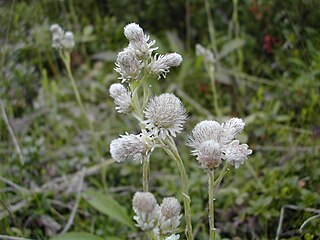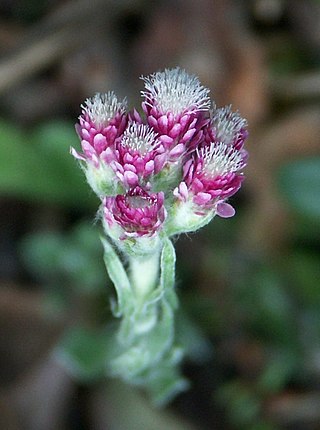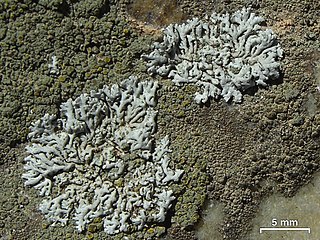
Antennaria is a genus of dioecious perennial herbs in the family Asteraceae, native to temperate regions of the Northern Hemisphere, with a few species in temperate southern South America; the highest species diversity is in North America. Common names include catsfoot or cat's-foot, pussytoes and everlasting.

Antennaria alpina is a European and North American species of plant in the family Asteraceae. Antennaria alpina is native to mountainous and subarctic regions of Scandinavia, Greenland, Alaska, and the Canadian Arctic, extending south at high altitudes in mountains in the Rocky Mountains south to Montana and Wyoming.

Antennaria dioica is a Eurasian and North American species of flowering plant in the family Asteraceae. It is a perennial herb found in cool northern and mountainous regions of Europe and northern Asia (Russia, Mongolia, Japan, Kazakhstan, China, and also in North America in Alaska only.

Antennaria howellii is a North American species in the genus Antennaria within the family Asteraceae. It is native to northern Alaska, much of Canada including the Arctic territories, and the northern United States as far south as northern California, Colorado and North Carolina.
Antennaria argentea is a North American species of flowering plants in the family Asteraceae known by the common name silver pussytoes or silvery everlasting. It is native primarily to Oregon and to northern and central California with additional populations in Nevada, Idaho, Montana, and Washington.

Antennaria corymbosa is a North American species of flowering plants in the family Asteraceae known by the common names flat-top pussytoes or meadow pussytoes. It is native to western Canada and the Western United States south as far as Tulare County in California and Rio Arriba County in New Mexico. It grows in moist, cool areas such as mountain meadows and riverbanks. Most of the populations are found in the Rocky Mountains, the Cascades, and the Sierra Nevada.

Antennaria media is a North American species of flowering plants in the family Asteraceae known by the common name Rocky Mountain pussytoes. It is native to western Canada and the Western United States from Alaska and Yukon Territory to California to New Mexico. It grows in cold Arctic and alpine regions, either at high latitudes in the Arctic or at high elevations in the mountains.
Antennaria pulchella is a North American species of flowering plants in the family Asteraceae known by the common names Sierra pussytoes and beautiful pussytoes. It is native primarily to high elevations in the Sierra Nevada from Nevada County to Tulare County, where it is a plant of the alpine climate. Additional populations occur on Lassen Peak in Lassen County, and also in Washoe County, Nevada.

Antennaria rosea is a North American species of flowering plant in the family Asteraceae known by the common name rosy pussytoes. Other common names include cat's foot and mountain everlasting. The second part of its scientific name, rosea, is Latin for pink. It is widespread across much of Canada including all three Arctic territories, as well as Greenland, the western and north-central United States, and the Mexican state of Baja California.

Antennaria umbrinella is a North American species of flowering plants in the family Asteraceae known by the common names umber pussytoes and brown pussytoes. It is native to southwestern Canada and the western United States as far south as Colorado, Coconino County in Arizona, and Tulare County in California). It grows in a variety of habitats at a variety of elevations, from lowland sagebrush steppe to subalpine meadows.

Antennaria microphylla is a stoloniferous perennial forb in the family Asteraceae. It is widespread across northern and western North America, from Alaska and the three Canadian Arctic territories east to Quebec and south to Minnesota, New Mexico, and California.

Antennaria parvifolia is a species of flowering plant in the family Asteraceae, known by the common names small-leaf pussytoes and Nuttall's pussytoes. It is native to western and central North America.

Antennaria plantaginifolia is a perennial forb native to the eastern North America, that produces cream colored composite flowers in spring.
Antennaria arcuata, the box pussytoes, is a North American species of plants in the family Asteraceae. It grows in the western part of the United States, in the States of Idaho, Wyoming, and Nevada.
Antennaria densifolia, the denseleaf pussytoes, is a North American species of plants in the family Asteraceae. It is native to western Canada and the US states of Alaska and Montana. It grows in subalpine-alpine limestone talus.
Antennaria parlinii is a North American species of flowering plants in the family Asteraceae known by the common name Parlin's pussytoes. It is widespread across eastern and central Canada and eastern and central United States, from Manitoba to Nova Scotia south as far as Texas and Georgia.
Antennaria rosulata is a North American species of flowering plant in the family Asteraceae known by the common name Kaibab pussytoes or woolly pussytoes. It is native to the Southwestern United States, in the states of Arizona, New Mexico, Colorado, and Utah.
Antennaria soliceps is a rare species of flowering plant in the family Asteraceae known by the common name Charleston Mountain pussytoes. It has been found only on Mount Charleston in Clark County in the southern part of the US state of Nevada.
Antennaria solitaria is a North American species of flowering plant in the family Asteraceae known by the common name singlehead pussytoes. It is found in the southeastern and east-central part of the United States from Delaware and southern Pennsylvania west to southern Illinois and south as far as Georgia and Louisiana.

Candelariella antennaria, or the pussytoes eggyolk lichen, is a lichen commonly distributed in North America, and has been observed in South America, Asia, Australia, and Europe. It is characterized by its gray thallus and bright yellow apothecia, as well as its very small size.













